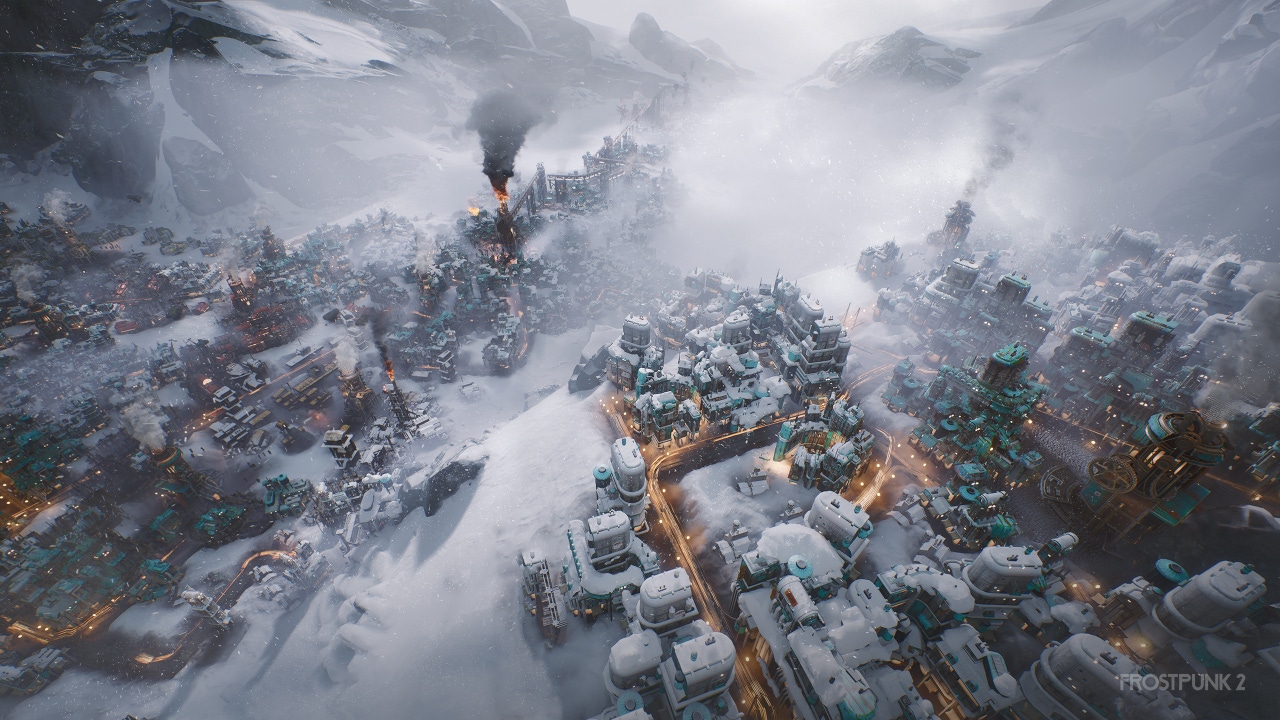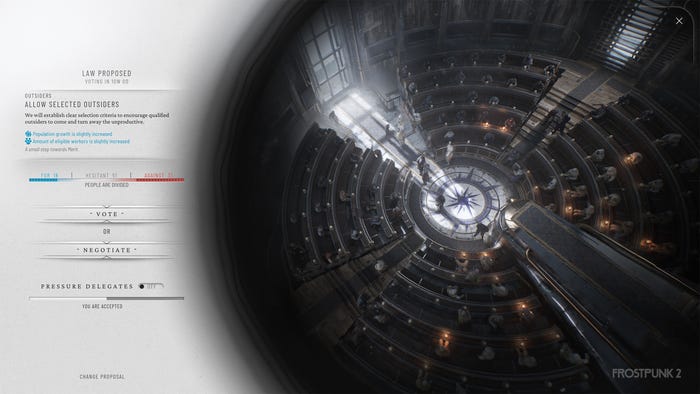Frostpunk 2 leans into "the human experience" of a city-builder
The developers at 11-Bit Studios explain how the intense sequel emphasizes the stories players build alongside their city.

The original Frostpunk was a compelling blend of a city-builder and a survival game, all wrapped in a story about keeping a community alive during a global ice age. Unlike other city-builders focusing on cause and effect, however, Frostpunk's world offers no respite—either make things work or see the citizens slowly succumb to the elements and internal turmoil. This unorthodox, survivalist take on a city-builder presented a harrowing story of surviving the apocalypse, all defined by your actions.
It was a city-builder that put a keen focus on examining the very people living in the city that players built. For the upcoming Frostpunk 2, game co-directors Jakub Stokalski and Łukasz Juszczyk were interested in letting the community craft an even more compelling story with their societies in the decades after the original catastrophe. I recently got to see an extended gameplay demo for the sequel, and the developers at 11-Bit Studios broke down their view on focusing more on "the human experience" within a city-builder survival game.
Life after the apocalypse
Frostpunk 2 deals with heavy subject matter, asking what it takes to keep a city running in a bleak setting and who should shoulder the burden over others. It's an incredibly dire setting, but according to Stokalski, the brutal atmosphere serves more to reveal opportunities for storytelling in a city-builder game. To the developers, players' choices in the context of their city will tell a unique story for everyone."The bleakness of the setting itself wasn't necessarily a core value of the game, but it did present a good opportunity for us—much like other fantasy and post-apocalyptic games—to examine and look at the idea of a blank slate after the apocalypse," said Stokalski. "The city and its citizens went through hell to survive, so what now?"
Set 30 years after the "great storm" from the original game, the city that made the tough calls to survive an endless winter has endured, building a new society and new way of life in the frozen wastes. Now, in the era following the apocalypse in an alternate early 1900s, Frostpunk 2 focuses on the growth of a new society trying to stay alive, and keeping a civilization that has adapted to new circumstances from falling apart.

For Frostpunk 2, maintaining the city and the well-being of its citizens—no longer just survivors—is only one part of the experience. The larger goal of the sequel is to let players define the city's society and build its future following the global disaster. Though decades have passed since the harsh beginnings, the city is more equipped to handle the environment. Crucially, it is still vulnerable to collapse due to poor management or societal collapse. With a new economy based on supply and demand, the city's infrastructure and management have been changed to fit the new economic and social order. Players need to navigate short-term fixes, long-term decision-making regarding resource allocation, or deciding which expansion should be invested in. Each choice will lead to consequences that could disturb society's fabric, triggering revolts from social factions and even putting the fate of the city's youth at risk.
Building a future for all, or just the lucky few
Compared to the first game, the complete size of Frostpunk 1's city makes up just one district in Frostpunk 2, which will grow throughout the story campaign and the utopia builder mode—the sequel's take on the endless mode from the original. Players also get to see that rapid growth with a more detailed game map that showcases the depth of the city, and its eventual move to a metropolis nestled in the frozen landscape.
According to game co-director and art director Łukasz Juszczyk, the approach to building out the city and its growth as a society was from real-life towns and cities that grew after hardship."It wasn't obvious to us at the beginning, but we eventually realized that Frostpunk 1 was not a post-apocalyptic game at all," said Juszczyk.
"It's often described that way because of the setting and themes, but it was, in actuality, a game about surviving the apocalypse as it happened, how a society would be able to make it through that. So for this game, we thought about what that society would look like after making it, similar to a post-war society, where traditions and customs have been altered because of recent events—those events from the first game truly shaped the setting in profound ways. That allowed us to come up with some creative ideas to apply to our characters and factions in Frostpunk 2, and the difficult choices they have to make to keep their society going."

The developers explained that Frostpunk 2 is about building the future, and often, the road to a better and more prosperous society is built on hardship and tragedy. A defining moment that gave me pause—which cements Frostpunk 2's commitment to putting the city's fate in the hands of players—is deciding what societal obligations should be placed on the city's youth.
In this demo, we saw the consequence of putting the city's children in menial jobs to shoulder the burden of adults in similar positions. This resulted in an incident in a Biowaste Hothouse used for fuel processing, leading to several child workers catching dysentery. The news of this outbreak upset the townspeople, especially the Engineer and Technocrat factions, who wish for children to remain in school to prepare for the city's future differently.
Frostpunk 2 continues with the original's morally ambiguous take on a city-builder, which made it such a standout in the genre. With parallels to real-world history from the Industrial Revolution (and from current events regarding climate change and the choices we could make to build a better future), Frostpunk 2 is digging deeper and hitting harder on themes that push the storytelling even further than the original game did. That could potentially make for a more profound and thoughtful take on city-building during a great period of uncertainty.
Read more about:
FeaturesAbout the Author
You May Also Like









